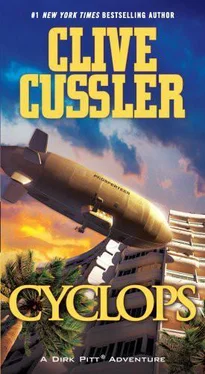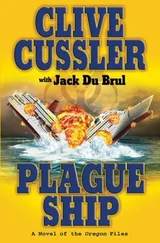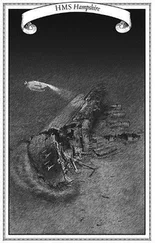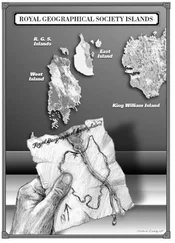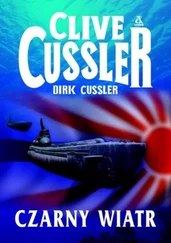"A true golden man," Pitt speculated. "A statue."
"You're close," said O'Meara. "Damned close, but you missed on the sex.'
"Sex?"
"La mujer dorada, the golden woman," O'Meara replied. "Or more commonly, La Dorada. You see, the name first applied to a man and a ceremony, later to a city, and finally to an empire. Over the years it became a term for any place where riches could be found on the ground. Like so many descriptions the feminists hate, the masculine myth became generic, while the feminine was forgotten. Ready for another drink?"
"No, thanks. I'll nurse this one."
O'Meara ordered another Jack Daniel's. "Anyway, you know the story behind the Taj Mahal. A Mogul ruler erected the ornate tomb as a monument to his wife. Same with a pre-Columbian, South American king. His name is not recorded, but, so the legend goes, she was the most beloved of the hundreds of women at his court. Then an event occurred in the sky. Probably either an eclipse or Halley's comet. And the priests called on him to sacrifice her to appease the angry gods. Life was no fun in those days. So she was killed, heart torn out in an elaborate ceremony."
"I thought only the Aztecs went in for heart removal."
"The Aztecs didn't have a monopoly on human sacrifice. The upshot was the king called together his artisans and ordered them to build a statue of her likeness so he could elevate her to a god."
"Did the monk describe it?"
"In vivid detail, if his story can be believed. She stands nude, nearly six feet tall, on a pedestal of rose quartz. Her body is solid gold. God, it must weigh at least a ton. Imbedded in the chest, where the heart should be, is a great ruby, judged to be in the neighborhood of twelve hundred carats."
"I don't profess to be an expert," said Pitt, "but I know that rubies are the most valuable of all the gemstones, and one of thirty carats is a rarity. Twelve hundred carats is unbelievable."
"That's not even the half of it," O'Meara continued. "The entire head of the statue is one gigantic carved emerald, deep blue-green and flawless. I can't begin to guess the carat weight, but it would have to hit the scales around thirty pounds."
"More like forty if you include a likeness of the hair."
"What's the largest known emerald?"
Pitt thought a moment. "Certainly no more than ten pounds."
"Can't you just see her standing under spotlights in the main lobby of Washington's Museum of Natural History," O'Meara said wistfully.
"I can only wonder at the value on today's market."
"You could safely say it's priceless."
"There was another man who saw the statue?" Pitt asked.
"Colonel Ralph Morehouse Sigler, a real character from the old explorer school. An engineer in the English army, he tramped around the empire, surveying boundaries and building forts throughout Africa and India. He was also a trained geologist and spent his leave time prospecting. He was either damned lucky or damned good, discovering an extensive chromite deposit in South Africa and several precious gemstone veins in Indochina. He became wealthy but didn't have time to enjoy it. The Kaiser marched into France and he was ordered to the Western Front to build fortifications."
"So he didn't enter South America until after the war."
"No, in the summer of 1916, he stepped off the boat at Georgetown, in what was then British Guiana. It seems some hotshot in the British treasury got the bright idea of sending out expeditions around the world to find and open gold mines to finance the war. Sigler was recalled from the front and ordered into the South American interior."
"You think he knew the monk's story?" Pitt asked.
"Nothing in his diaries or papers indicates he ever believed in a lost city. The guy was no wild-eyed treasure hunter. He was after raw minerals. Historic artifacts never interested him. Are you hungry, Dirk?"
"Yes, come to think of it. I was cheated out of dinner."
"We're long past the dinner hour, but if we ask nice I'm sure the kitchen can rustle up some appetizers."
O'Meara gestured for the barmaid and after pleading his case persuaded her to serve them a platter of shrimp with cocktail sauce.
"Hits the spot," said Pitt.
"I could eat these little devils all day long," O'Meara agreed. "Now, where were we?"
"Sigler was about to find La Dorada."
"Oh, yes. After forming a party of twenty men, mostly British soldiers, Sigler plunged into the uncharted wilds. For months, nothing was heard of them. The British began to sense disaster and sent out several search parties, but none found a trace of the missing men. At last, nearly two years later, an American expedition, surveying for a railroad, stumbled upon Sigler five hundred miles northeast of Rio de Janeiro. He was alone, the only survivor."
"Seems like an incredible distance from British Guiana."
"Almost two thousand miles from his jump-off point as the crow flies."
"What kind of shape was he in?"
"More dead than alive, according to the engineers who found him. They carried Sigler to a village that had a small hospital and sent off a message to the nearest American consulate. A few weeks later a relief party arrived from Rio."
"American or British?"
"An odd twist there," answered O'Meara. "The British consulate claimed they were never notified of Sigler's reappearance. Gossip had it that the American consul general himself showed up to question him. Whatever happened, Sigler dropped from sight. The story is he escaped from the hospital and wandered back into the jungle."
"Doesn't figure that he'd turn his back on civilization after two years of hell," said Pitt.
O'Meara shrugged. "Who can say?"
"Did Sigler give an account of his expedition before he disappeared?"
"Raved in delirium most of the time. Witnesses said afterward that he babbled about finding a huge city surrounded by steep cliffs and overgrown by jungle. His description pretty much matched the Portuguese monk's. He also drew a rough sketch of the golden woman that was saved by a nurse and now lies in Brazil's national library. I had a look at it while researching another project. The real thing must be an awesome sight."
"So it remains buried in the jungle."
"Ah, there's the rub," sighed O'Meara. "Sigler claimed he and his men stole the statue and dragged it twenty miles to a river, fighting off the Zanona Indians the whole trip. By the time they built a raft, heaved La Dorada on board, and pushed off, there were only three of them left. Later one died of his injuries and the other was lost in a stretch of rapids."
Pitt was fascinated by what O'Meara was telling him, but he was having a hard time keeping his eyes open. "The obvious question is, where did Sigler stash the golden woman?"
"If I only knew," replied O'Meara.
"Didn't he give a clue?"
"The nurse thought he said the raft came apart and the statue dropped into the river a few hundred yards from where the surveyors' party found him. But don't get your hopes up. He was muttering nonsense. Treasure hunters have been dragging metal detectors up and down that river for years without a reading a tick."
Pitt swirled the ice cubes around inside his glass. He knew, he knew what happened to Ralph Morehouse Sigler and La Dorada.
"The American consul general," Pitt said slowly, "he was the last person to see Sigler alive?"
"The puzzle gets cloudy at this point, but as near as anyone can tell, the answer is yes."
"Let me see if I can fill in the pieces. This took place in January and February of 1918. Right?"
O'Meara nodded, and then he gave Pitt a queer stare.
"And the consul general's name was Alfred Gottschalk, who died a few weeks later on the Cyclops. Right?"
"You know this?" said O'Meara, his eyes uncomprehending.
"Gottschalk probably heard of Sigler's mission through his counterpart at the British consulate. When he received the message from the railroad surveyors that Sigler was alive, he kept the news to himself and headed into the interior, hoping to interview the explorer and steal a jump on the British by turning over any valuable information to his own government. What he learned must have shattered any code of ethics he still retained. Gottschalk decided to grab the bonanza for himself.
Читать дальше
